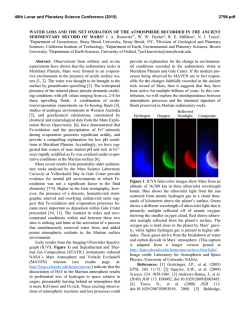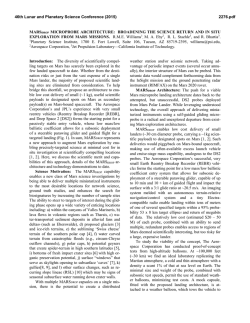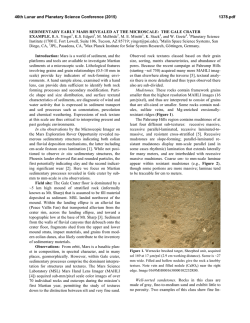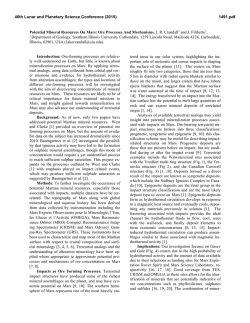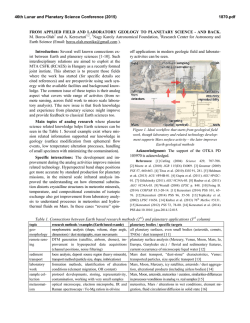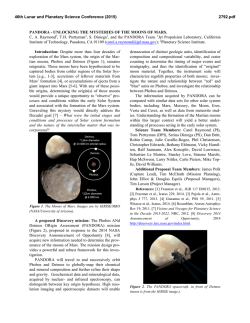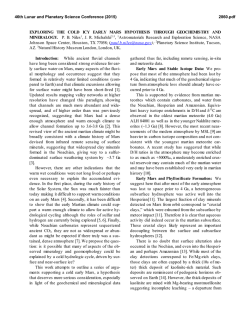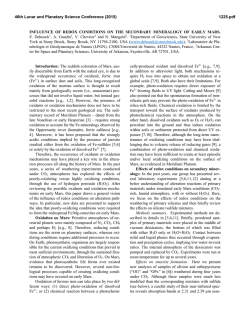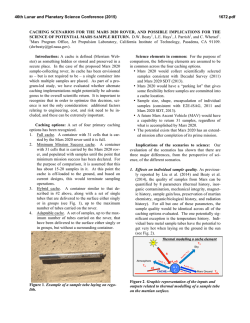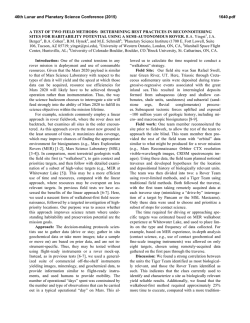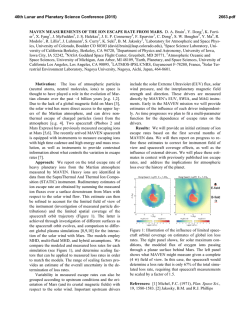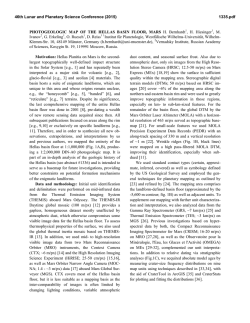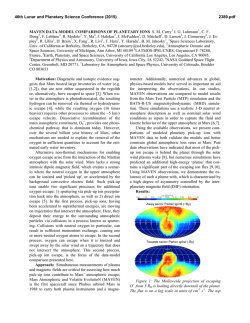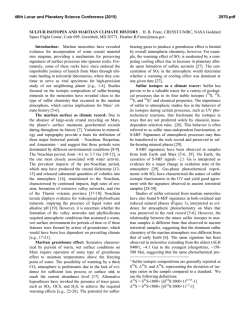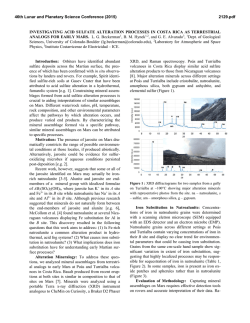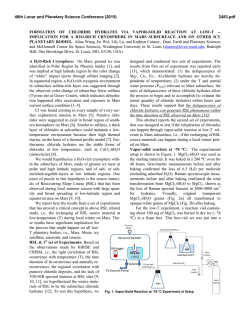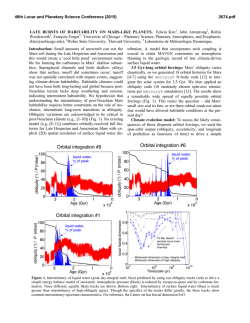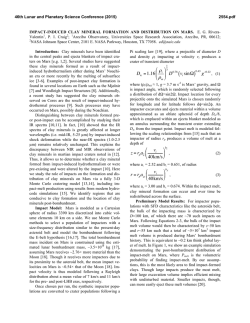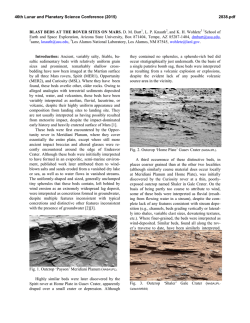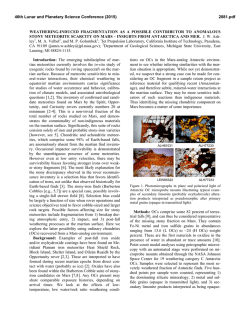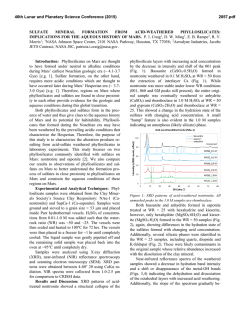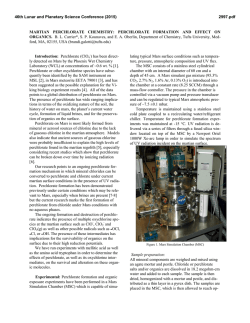
The Importance of Fe-Redox Processes in Groundwater Chemistry
46th Lunar and Planetary Science Conference (2015) 2769.pdf THE IMPORTANCE OF FE-REDOX PROCESSES IN GROUNDWATER CHEMISTRY ON EARTH AND MARS. J. A. Hurowitz1*, W. W. Fischer2, J. P. Grotzinger2, S. M. McLennan1, N. J. Tosca3, 1Department of Geosciences, Stony Brook University, Stony Brook, NY, 2Division of Geological and Planetary Sciences, California Institute of Technology, 3Department of Earth Sciences, University of Oxford, *[email protected]. Introduction: For nearly a decade, the international program of Mars exploration has been guided by a remarkably useful framework that describes how Mars’ environmental conditions have evolved in the context of time-dependent changes in the mineralogy of rock and regolith deposits at the Martian surface [1]. Built on the basis of observations by the OMEGA spectrometer onboard ESA’s Mars Express Orbiter, this framework describes an early era of neutral-pH environments in which clay mineral formation was important. At around the Noachian-Hesperian boundary (~3.5-3.8 Ga), these clay forming environments give way to sulfate minerals formed under evaporative, low-pH conditions that are thought to reflect volcanic input of S-bearing gases to surface waters. Ongoing observations by Mars Express and the higher-resolution instruments onboard NASA’s Mars Reconnaisance Orbiter have continued to refine and extend this paradigm [e.g., 2-4], but as is the case on Earth, the greatest insight into the evolution of surface environments comes from close-up examination of the sedimentary rock record. In-situ observations of sedimentary strata by NASA’s Opportunity and Curiosity rovers enable evaluation of hypotheses developed from orbit, and reveal that iron-based redox processes have played a critical role in the mineralogic evolution of the Martian surface [e.g., 5]. Here, we describe some important aspects of redox processes in Fe-bearing waters, using the chemistry of basaltic groundwaters on Earth as a guide [6-8]. We then discuss examples from Meridiani Planum and Gale Crater on Mars that highlight the power of Febased redox processes to affect water chemistry and sedimentary mineralogy. On the basis of these examples, we suggest that the observed transition from neutral-pH, clay forming environments to those in which acid-sulfate minerals were important reflects a change in the availability of oxidants, rather than a change in the rate of volcanic outgassing. Dissolved Fe-chemistry on Earth: Examples from Iceland and Siberia: On Fig.1, we plot pH versus the activity of dissolved Fe, showing the speciation of dissolved Fe3+ (blue fields) and the field of Fe(OH)3 stability (tan field). Owing to the presence of significant O2 in the terrestrial atmosphere, meteoric waters will evolve along a pathway described by the black arrow as they enter a basaltic aquifer and undergo neutralization via water-rock reaction. As a result of the insoluble nature of the Fe(OH)3 formed under these conditions, dissolved Fe concentrations tend to remain vanishingly low (<1M), despite the fact that there is an abundance of Fe available in the host basaltic aquifer. This is apparently the case even in deep, evolved groundwaters which are completely removed from contact with the atmosphere (e.g., Iceland groundwaters, denoted by small white circles on Fig. 1). In Siberian groundwater systems (small green circles on Fig. 1), degradation of organic matter derived from extensive swamps which overlie the aquifer results in the production of carbonic acid. This acidity lowers pH, and under anoxic conditions, provides an opportunity for dissolved Fe2+ concentrations to rise to levels higher than those seen in Icelandic groundwaters. In this case, waters evolve along the green arrow as fluids undergo neutralization, and the combination of high Fe2+ and dissolved carbonate results in the precipitation of siderite (FeCO3; equilibrium between Fe2+ and siderite denoted by dashed green line), which is observed in abundance in the Siberian aquifer [7]. The mechanism by which Fe-rich groundwaters are generated in Siberia must be a uniquely terrestrial process. Measurements of organic concentrations in rocks and soils on Mars do not support the possibility that organic matter degradation played a significant role in surface or subsurface water chemistry on Mars [9, 10]. And in any case, limited evidence for a substantial carbonate mineral record on Mars seems to indicate that other sources of carbonic acid (e.g., atmospheric CO2) played a relatively minor role in the chemistry of Martian waters. It is reasonable to ask then: is it at all possible to generate Fe-rich groundwaters on Mars? Dissolved Fe-chemistry on Mars: Examples from Gale Crater and Meridiani Planum: Superimposed on Fig. 1, the solid and dashed black line describes the relationship between dissolved Fe2+ and Fe(OH)2, a ferrous hydroxide phase that can serve as a precursor to the formation of authigenic magnetite [11] and/or iron-phyllosilicate minerals in the presence of dissolved silica [12]. Critically, Fe(OH)2 requires anoxic conditions in order to form and may be responsible for the authigenic magnetite observed by the Curiosity rover at Yellowknife Bay in Gale Crater [11, 13]. In the presence of Fe(OH)2, the solubility relationships for Fe differ dramatically from what was described from examples on the modern Earth. As shown on Fig. 1, equilibrium with relatively soluble Fe(OH)2 sets the dissolved Fe-concentration at 71mM, or close 46th Lunar and Planetary Science Conference (2015) to 4000ppm, at pH = 7. In fact, above pH 9.86 (gold star on Fig. 1) Fe-concentrations change by ~2 orders of magnitude for each unit change in pH. Accordingly, authigenic magnetite at Gale Crater may provide a tantalizing hint that water chemistry at this location on Mars was influenced by anoxic conditions in which Fe-concentrations were high and controlled by equilibrium with a relatively soluble ferrous mineral phase(s). If we take this scenario a step further, we can pose the following questions, which are relevant to the Burns Formation at Meridiani Planum, investigated in detail by the Opportunity rover: what are the consequences of the oxidation of such Fe-rich waters after they are formed? Can they produce the acidity required to explain the low-pH conditions recorded by the Burns Formation sedimentary rocks [3, 5]? To the right of the pH-activity diagram on Fig. 1, we have modeled the consequences of Fe2+ oxidation and acid production from Fe-hydrolysis as Fe2+ is oxidized from equilibrium with Fe(OH)2 at initial pH values of 7, 8, and 9, and Fe(OH)3 is formed in its place. As indicated, the change in pH resulting from this process is dramatic, with final pH values ranging from 0.9 to 5.4 depending on the initial pH-dependent Feconcentration. These pH changes represent an upper limit, as we have not taken complexation between H+ 2769.pdf and other ions into account, but the scale of pH change that results from oxidation of a neutral to alkaline, anoxic, Fe2+ bearing water is nevertheless impressive. In summary, we suggest that on the basis of the relationships described above, changes in the availaibility of oxidants to Fe-rich surface and groundwaters on Mars may have been the critical step in changing the surface environment from one in which clay minerals were formed to one in which acid-pH minerals dominated. The possibility that the change from anoxic to oxidizing conditions recorded in the layered sedimentary strata of Mars reflects global changes in atmospheric composition is worthy of further investigation. References: [1] Bibring, J.P., et al. (2006) Science 312, 400-404. [2] Ehlmann, B.L., et al. (2011) Nature 479, 53-60. [3] Grotzinger, J. and Milliken, R., eds. (2012) Sedimentary Geology of Mars. SEPM Special Publication 102. [4] Murchie, S.L., et al. (2009) JGR 114, 30. [5] Hurowitz, J.A., et al. (2010) Nat. Geosci. 3, 323-326. [6] Arnorsson, S.N., et al. (2002) GCA 66, 4015-4046. [7] Ivanova, I.S., et al. (2014) Water Resour. 41, 163-177. [8] Stefansson, A., et al., (2005) Chem. Geo. 221, 289-311. [9] Leshin, L.A., et al. (2013) Science 341, 10.1126/science.1238937. [10] Ming, D.W., et al. (2014) Science 343, 10.1126/science.1245267. [11] Tosca, N.J. and Hurowitz, J.A., in 2014 Goldschmidt: Sacramento, CA. [12] Harder, H. (1978) Clays and Clay Minerals 26, 65-72. [13] Vaniman, D.T., et al. (2013) Science 343, 10.1126/science.1243480.
© Copyright 2025
